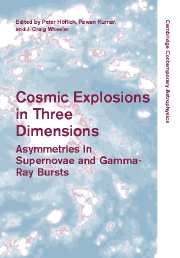Book contents
- Frontmatter
- Contents
- Part I Introduction
- Part II Supernovae: Observations Today
- Part III Theory of Thermonuclear Supernovae
- Part IV Theory of Core Collapse Supernovae
- 22 Rotation in core collapse progenitors: single and binary stars
- 23 Large scale convection and the convective supernova mechanism
- 24 Topics in core-collapse supernova-theory
- 25 MHD supernova jets: the missing link
- 26 Effects of super-strong magnetic fields in a core collapse supenova
- 27 Non-radial instability of stalled accretion shocks: advective-acoustic cycle
- 28 Asymmetry effects in hypernovae
- 29 Stellar abundances: the r-process and supernovae
- Part V Magnetars, N-Stars, Pulsars
- Part VI Gamma-ray Bursts
- Part VII Conference Summary
- References
26 - Effects of super-strong magnetic fields in a core collapse supenova
Published online by Cambridge University Press: 11 August 2009
- Frontmatter
- Contents
- Part I Introduction
- Part II Supernovae: Observations Today
- Part III Theory of Thermonuclear Supernovae
- Part IV Theory of Core Collapse Supernovae
- 22 Rotation in core collapse progenitors: single and binary stars
- 23 Large scale convection and the convective supernova mechanism
- 24 Topics in core-collapse supernova-theory
- 25 MHD supernova jets: the missing link
- 26 Effects of super-strong magnetic fields in a core collapse supenova
- 27 Non-radial instability of stalled accretion shocks: advective-acoustic cycle
- 28 Asymmetry effects in hypernovae
- 29 Stellar abundances: the r-process and supernovae
- Part V Magnetars, N-Stars, Pulsars
- Part VI Gamma-ray Bursts
- Part VII Conference Summary
- References
Summary
Abstract
Polarization and other observations indicate that supernova explosions are aspherical and often axisymmetric, implying a necessary departure from spherical models. Akiyama et al. investigated the effects of the magneto-rotational instability (MRI) on collapsing and rotating cores. Their results indicate that the MRI dynamo generates magnetic fields of greater than the Q.E.D. limit (4.4 × 1013 G). We present preliminary results of the effects of the super-strong magnetic field on degenerate electron pressure in core collapse.
Introduction
Although core collapse cannot be observed directly, except with neutrinos, observations of explosion ejecta can provide us with information about the explosion mechanism itself. Such observations indicate that explosions of core collapse supernovae are aspherical and often bipolar. HST observations clearly show that 1987A has aspherical ejecta for which the axis aligns roughly with the small axis of the rings (Pun et al. 2001; Wang et al. 2002). Spectropolarimetry is a powerful tool for probing ejecta asphericity, and it reveals that most, if not all, core collapse supernovae possesses asphericity and often times bipolar structure (Wang et al. 1996, 2001). Explosions of Type Ib and Ic are more strongly aspherical, while the asphericity of Type II supernovae increases with time as the ejecta expand and the photosphere recedes (Wang et al. 2001; Leonard et al. 2000, 2001). The indication is that it is the core collapse mechanism itself that is responsible for the asphericity.
The observational evidence of asphericity motivates the inclusion of rotation in core collapse physics.
- Type
- Chapter
- Information
- Cosmic Explosions in Three DimensionsAsymmetries in Supernovae and Gamma-Ray Bursts, pp. 231 - 237Publisher: Cambridge University PressPrint publication year: 2004
References
- 1
- Cited by



